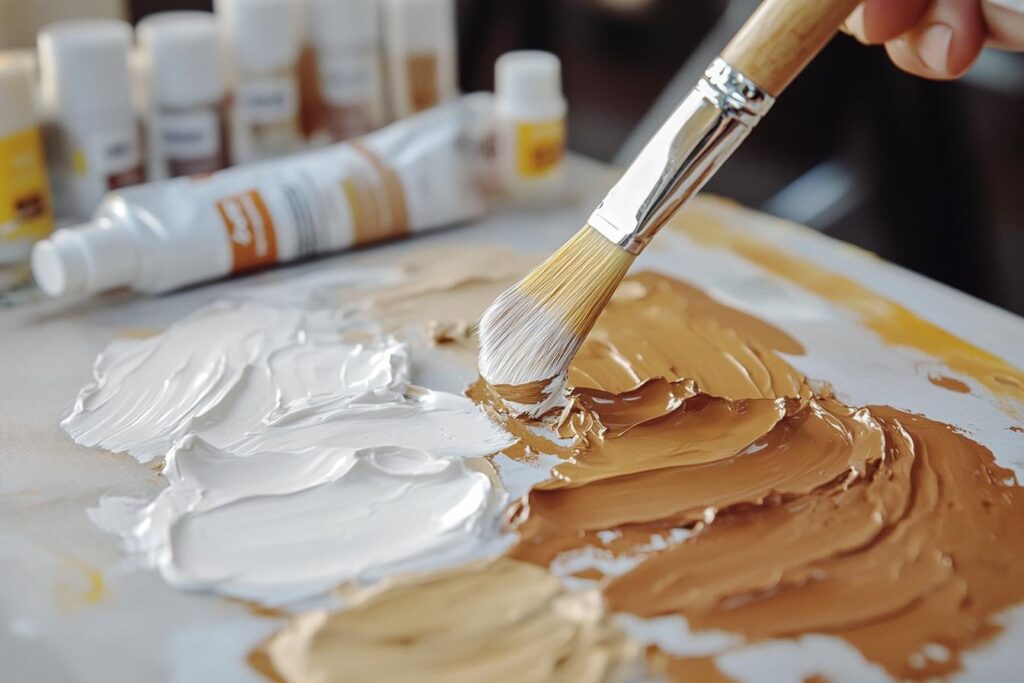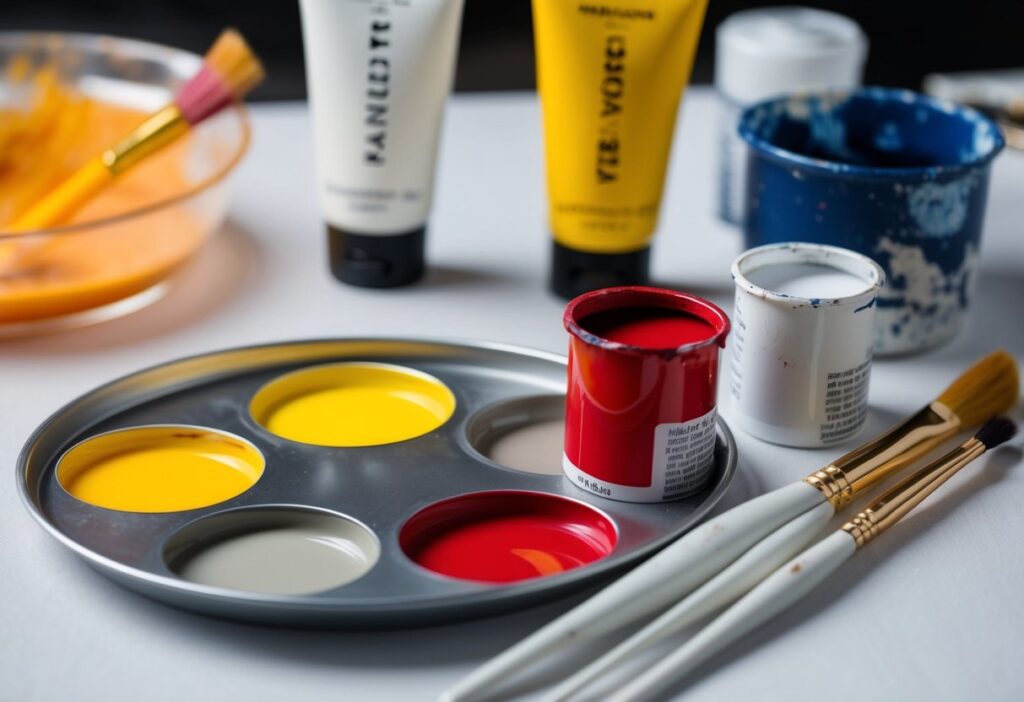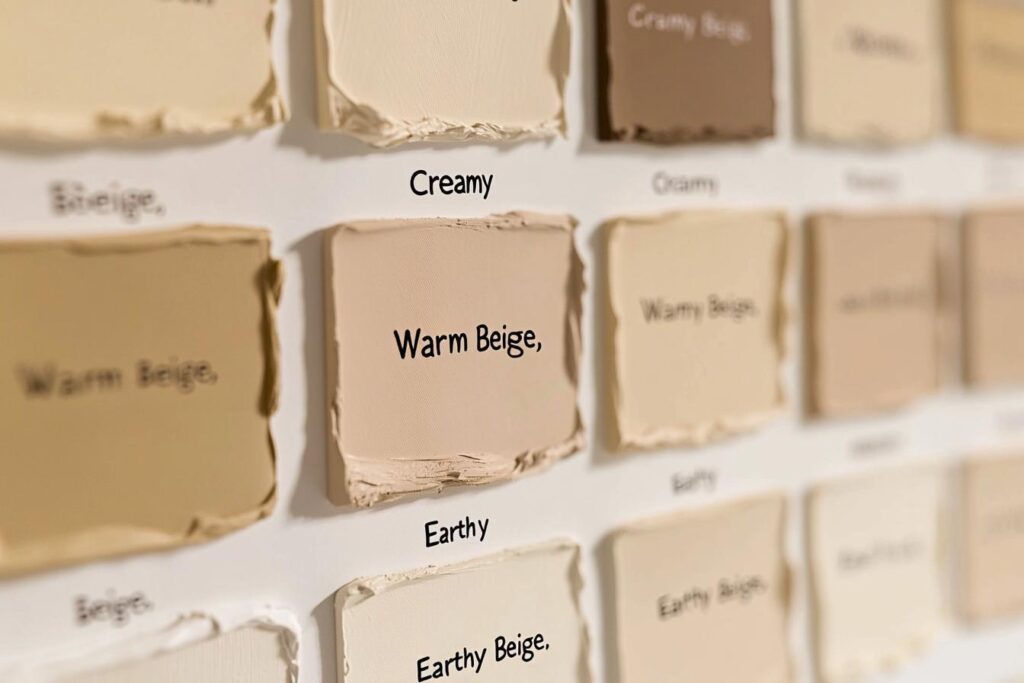How To Make Beige Color Paint: Easy Steps for Perfect Shades
Creating your own beige paint at home is easier than you might think, and it can save you a trip to the store. To make beige paint, you’ll need a white base and a touch of brown paint to adjust the shade to your liking. You can experiment with small amounts of raw sienna or raw umber to achieve the exact tone you desire. Mixing in yellow can also introduce warmth to your beige, offering a soft and creamy hue.

Picture this: your DIY paint project is underway, and you’re crafting the perfect beige color for your walls or art. Think of the satisfaction you’ll feel knowing you mixed this shade yourself. Not only is it fun, but it also gives you control over the color outcome. Adding pigments little by little allows you to see how the shade evolves.
Get the Fail-Safe Paint Color Playbook (Free PDF)
36 proven colors • 8 ready palettes • trim & sheen guide • printable testing cards.
If you’re mixing acrylics or any other type of paint, start with a 1:3 ratio of yellow to white or adjust with more brown if needed. The key is mixing thoroughly to blend all the colors uniformly. This way, you’ll get an even and smooth beige, ready to transform any surface. How exciting is that?
Understanding Beige and Its Varieties
Beige is a versatile color that comes in many shades, from soft creams to earthy khakis. It serves as a warm background for other colors and is easy to mix.
The Basics of Beige
Beige is a neutral color often seen as warm and relaxing. It’s created by blending various hues like white, brown, yellow, and sometimes even a touch of green. These combinations give beige its earthy feel.
Think of beige as the color of a sandy beach or a cozy sweater. Because it’s neutral, it pairs well with almost any color palette, making it a popular choice for home interiors and art projects. You can achieve a warm beige by starting with a white base, then adding a small amount of yellow or brown.
Fun fact: Ancient civilizations have used beige pigments in their art and decoration, making it a timeless choice.
Exploring Shades of Beige
Did you know there are so many different shades of beige? From cream to khaki, each variety tells its own story. Cream color is on the lighter side, often used for a soft, clean look. It adds a gentle tone to any design without being too bright.
Then, you’ve got khaki, a more earthy tone that leans towards green. It’s often seen in safari-style fashion and can add depth to any room or artwork.
If you want to create these hues, you can use equal parts of red and orange for a warm base, then gradually add white until you reach your desired shade. Testing with small amounts first allows you to tweak undertones as needed.
The Science of Color Mixing

When mixing paints, you dive into an exciting world that involves primary and secondary colors. Understanding how these colors interact and the concept of complementary colors can help you create the perfect shade every time.
Primary and Secondary Colors
Primary colors—red, blue, and yellow—are the building blocks in the world of color mixing. They cannot be made by blending other colors. Think of them as the ingredients in a recipe. By combining primary colors, you get secondary colors.
Mix to Create Secondary Colors:
- Red + Blue = Purple
- Blue + Yellow = Green
- Yellow + Red = Orange
Each mixture produces a secondary color, paving the way for more complex shades. Isn’t it fascinating how three simple colors can transform into an endless palette? With an understanding of these basics, you can master any paint project!
Complementary Colors Explained
The color wheel offers more than just a rainbow. It also helps you see complementary colors. These are pairs of colors directly opposite each other on the wheel, such as red and green, blue and orange, and yellow and purple.
Get the Fail-Safe Paint Color Playbook (Free PDF)
36 proven colors • 8 ready palettes • trim & sheen guide • printable testing cards.
Using complementary colors can create balance and harmony in your mixtures. For example, adding a touch of its complement can mute a color, giving you softer, less vibrant tones. Explore your creative side by experimenting with these dynamic duos and see how they affect your paint mixtures. Remember, using a color wheel makes it easier to find the perfect match every time!
Materials and Tools Required
Creating beige paint requires some specific materials and tools. You will need to select the appropriate paints and gather handy brushes and accessories to get the job done effectively.
Choosing the Right Paints
The type of paint you choose plays a big role in the final outcome. If you’re working with acrylics, you will find it’s easy to mix and quick to dry. Acrylic paint is versatile and can be thinned with water or an acrylic medium, making it perfect for detailed work.
For long-lasting results, oil paint provides rich texture and depth but requires a longer drying time. It’s a great choice if you want to layer colors without losing the subtle undertones of beige. On the other hand, watercolors and tempera paint offer lighter coverage and may not be suitable for wall painting but are excellent for small projects or paper canvases.
A basic list of items includes:
- White paint as a base
- Yellow paint for warmth
- Optional: red or brown for deeper tones
Brushes and Accessories
The choice of brush is just as important as the paint itself. Selecting the right brushes will help you apply your beige mix smoothly. A flat or wide brush can cover large areas quickly, while a smaller, round brush is good for edges or detail work.
Consider a paint tray to hold your mix and prevent spills. A high-quality stir stick will ensure your paints are well-combined. If you’re working with acrylic paint, adding an acrylic medium can alter the paint’s texture and drying time, providing you more control over the appearance.
Don’t forget essentials like drop cloths to protect your workspace and painter’s tape for neat edges. A good setup helps keep the project stress-free.
Mixing the Perfect Beige Shade
Creating the perfect beige paint is easy with a few essential tips and color combinations. You’ll learn how to mix paints using acrylics and oils, and how to alter the tones to suit your needs.

Beige with Acrylics
To make beige with acrylic paints, you’ll need three main colors: white, brown, and yellow. Start with a base of white paint. Add small amounts of light brown to it. Mix well and continue adding until you achieve a beige color that you like. If that’s missing a certain warmth, add a touch of yellow paint to bring life into the mix.
Acrylics dry quickly, so work in a small batch first. If you want a darker beige, use more brown; for a lighter shade, increase the white.
Get the Fail-Safe Paint Color Playbook (Free PDF)
36 proven colors • 8 ready palettes • trim & sheen guide • printable testing cards.
Beige with Oil Paints
Oil paints are slow-drying, allowing you more time to experiment. Begin with white oil paint as your base. Gradually mix in brown oil paint until you get a pleasing beige. This might take a little patience but ensures a smooth, creamy finish.
For a softer, muted beige, add a small amount of yellow to the mix. Unlike acrylics, oils keep their color when dry, which means you can trust that the wet color is what you’ll see after it dries. This is great if you’re aiming for consistency in your artwork.
Adjusting Beige Tones
Want to tweak your beige for that perfect shade? No worries! For a less yellow look, balance your mix by adding more brown or white paint. To make beige warmer, introduce more yellow, but go easy as too much can overpower.
If you need to make it look a bit lighter, simply add increments of white paint. For a subtle deeper tone, mix in brown sparingly. These small adjustments can make a big difference, so test on a small scale first. Keep some notes; it can help recreate that perfect beige you’re aiming for.
Get the Fail-Safe Paint Color Playbook (Free PDF)
36 proven colors • 8 ready palettes • trim & sheen guide • printable testing cards.
Creating Custom Beige Variations
Mixing custom beige shades lets you explore different tones that range from creamy lights to warm and earthy hues. By understanding the right combinations, you can create homemade beige paint that perfectly suits your artistic needs.

Achieving Creamy Beige
To create a creamy beige, start with a base of white paint. Slowly add small amounts of light brown or yellow ochre. Stir well after each addition.
Test your mixture frequently. You want a soft, buttery tone without too much darkness. If you go a bit too dark, lighten it by adding more white. Creamy beige suits interiors needing a subtle, warm touch. It reflects a gentle glow, making spaces appear brighter and more inviting.
Crafting Warm Beige Tones
To make warm beige, use red and orange to introduce vibrant undertones. A good starting point is to mix equal parts of light brown with a dab of orange.
Gradually add these colors to your white base, paying close attention to achieve a delicate balance. Warm beige exudes coziness, making it ideal for living rooms or bedrooms. This shade radiates warmth and comfort, often evoking feelings of safety and homeliness. You might call it a color hug!
Get the Fail-Safe Paint Color Playbook (Free PDF)
36 proven colors • 8 ready palettes • trim & sheen guide • printable testing cards.
Producing Earthy Beige Hues
Earthy beige shades require a mixture of darker colors like raw sienna or umber. Begin by adding these to your white paint until the mixture resembles a sandy or stone color.
Earthy tones bring depth and richness, inspired by nature’s palette. They work well in spaces that need a grounded, natural feel. Think of them as a backdrop for wooden or green accents. These hues often enhance the aesthetic of outdoor-inspired designs and add a touch of nature indoors.
Advanced Techniques and Tips
Mastering beige paint involves tricks and knowledge like manipulating lighting and diving into color psychology. These elements can help you tailor your beige to meet precise artistic needs.

Manipulating Lighting Conditions
Paint looks different in various lights, and lighting plays a huge role in color perception. Using natural sunlight can make beige look warmer, while fluorescent lights might wash it out. Try experimenting with different bulbs to see how your beige changes.
Use lamps and spotlights to highlight your beige, playing with soft and direct lighting. This technique lets you see the full potential of your beige, capturing different tones and shades at various times of day. Consider getting LED bulbs that mimic sunlight, helping maintain consistent color.
Understanding Color Psychology
Did you know beige is calming and neutral? It’s a favorite in home decor for its soothing vibes. Beige balances warm and cool tones, making it versatile for different settings.
Try pairing beige with blues or greens for a tranquil space, or with reds and oranges for a more dynamic feel. These combinations tap into psychological responses, creating the desired mood for your space. This thoughtful approach lets you choose beige wisely, matching it with the purpose you have in mind.
Remember, mastering beige doesn’t just stop at paint; it extends to understanding its impact in a room or artwork!
Finishing and Preservation
Creating a smooth, lasting beige paint doesn’t end with mixing colors. You’ll want to focus on sealing and protecting your work, ensuring that your paint maintains its quality and vibrance over time.
Sealing and Protecting Your Paint
Once your beige masterpiece is complete, sealing it is crucial. This protective layer helps shield the paint from dust, moisture, and damage. For acrylic paints, using an acrylic medium is a great option. It’s like giving your work a raincoat, keeping it safe from the elements.
Toners, useful for subtle color adjustments, can be sealed too. Optional: after your paint is dry, apply a clear sealant. This not only protects the surface but enhances color depth and brightness. With these steps, your beige will stay beautiful for years to come.
Frequently Asked Questions
Creating beige paint involves mixing specific colors and adjusting to achieve the perfect shade. Understanding how to adjust the mix allows you to tailor your color to any project, be it art or home decor.
What two colors can I mix to create a beige shade for my next art project?
To make beige, you can mix white and brown paint together. Start with white as your base and then slowly add brown until you achieve a soft beige tone. Adjusting the brown will help lighten or darken the beige to your liking.
Can you guide me on achieving the perfect beige color paint for my living room walls?
For living room walls, mix a majority of white paint with just a small amount of yellow paint to achieve a warm beige. Ensure you have enough paint mixed at once to cover your whole wall area to keep the shade consistent.
Get the Fail-Safe Paint Color Playbook (Free PDF)
36 proven colors • 8 ready palettes • trim & sheen guide • printable testing cards.
What’s the secret to making a creamy beige paint for a warm and inviting home ambiance?
Adding a touch of sienna to your white base can create a creamy beige with a warm feel. Don’t forget to test your shade in a small area first to make sure it gives the inviting vibe you’re aiming for.
How can I darken beige paint if the shade is too light for my taste?
If your beige is too light, mix in a little more brown paint or add a touch of raw umber to deepen the tone. This helps you achieve a richer hue without affecting the warmth of your beige.
Are there ways to make beige color paint without using brown as a base?
Certainly! You can craft beige by combining white with a mix of yellow and a dab of grey paint. This combination offers a different kind of beige shade without the typical brown base everyone expects.
What combination of hues will yield a tan or beige color for my watercolor illustrations?
For watercolor illustrations, start with a base of white and mix in yellow and a bit of brown. Adjust the color by adding more water or pigment until you reach the ideal tan or beige tone suitable for your artwork.
